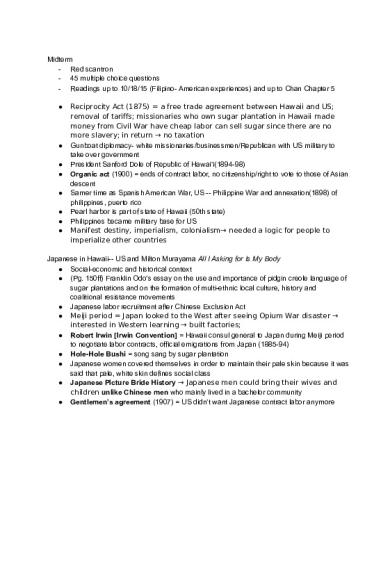10 18 16 Lecture Notes - review on chapter 2 PDF

| Title | 10 18 16 Lecture Notes - review on chapter 2 |
|---|---|
| Course | Historical Experience of Asian Americans |
| Institution | University of California Davis |
| Pages | 1 |
| File Size | 69.4 KB |
| File Type | |
| Total Downloads | 66 |
| Total Views | 134 |
Summary
review on chapter 2...
Description
Midterm - Red scantron - 45 multiple choice questions - Readings up to 10/18/15 (Filipino- American experiences) and up to Chan Chapter 5 ●
● ● ● ● ● ● ●
Reciprocity Act (1875) = a free trade agreement between Hawaii and US; removal of tariffs; missionaries who own sugar plantation in Hawaii made money from Civil War have cheap labor can sell sugar since there are no more slavery; in return → no taxation Gunboat diplomacy- white missionaries/businessmen/Republican with US military to take over government President Sanford Dole of Republic of Hawai’i(1894-98) Organic act (1900) = ends of contract labor, no citizenship/right to vote to those of Asian descent Samer time as Spanish American War, US -- Philippine War and annexation(1898) of philippines, puerto rico Pearl harbor is part of state of Hawaii (50th state) Philippines became military base for US Manifest destiny, imperialism, colonialism→ needed a logic for people to imperialize other countries
Japanese in Hawaii-- US and Milton Murayama All I Asking for Is My Body ● Social-economic and historical context ● (Pg. 150ff) Franklin Odo’s essay on the use and importance of pidgin creole language of sugar plantations and on the formation of multi-ethnic local culture, history and coalitional resistance movements ● Japanese labor recruitment after Chinese Exclusion Act ● Meiji period = Japan looked to the West after seeing Opium War disaster → interested in Western learning → built factories; ● Robert Irwin [Irwin Convention] = Hawaii consul general to Japan during Meiji period to negotiate labor contracts, official emigrations from Japan (1885-94) ● Hole-Hole Bushi = song sang by sugar plantation ● Japanese women covered themselves in order to maintain their pale skin because it was said that pale, white skin defines social class ● Japanese PIcture Bride History → Japanese men could bring their wives and children unlike Chinese men who mainly lived in a bachelor community ● Gentlemen’s agreement (1907) = US didn’t want Japanese contract labor anymore...
Similar Free PDFs

Lecture 16-18 Notes
- 7 Pages

Chapter 16 - Lecture notes 10
- 5 Pages

Cs - Lecture notes 16-18
- 29 Pages

Chapter 18 - Lecture notes 18
- 21 Pages

Chapter 18 - Lecture notes 18
- 14 Pages

Chapter 18 - Lecture notes 18
- 26 Pages

Chapter 18 - Lecture notes 18
- 13 Pages

Chapter 16 - Lecture notes 16
- 11 Pages

Chapter-18 - Lecture notes
- 5 Pages

Lecture notes chapter 16
- 16 Pages

Chapter 16 Lecture Notes
- 26 Pages

Chapter 16 Lecture Notes
- 29 Pages

Chapter 16 Notes #2
- 4 Pages
Popular Institutions
- Tinajero National High School - Annex
- Politeknik Caltex Riau
- Yokohama City University
- SGT University
- University of Al-Qadisiyah
- Divine Word College of Vigan
- Techniek College Rotterdam
- Universidade de Santiago
- Universiti Teknologi MARA Cawangan Johor Kampus Pasir Gudang
- Poltekkes Kemenkes Yogyakarta
- Baguio City National High School
- Colegio san marcos
- preparatoria uno
- Centro de Bachillerato Tecnológico Industrial y de Servicios No. 107
- Dalian Maritime University
- Quang Trung Secondary School
- Colegio Tecnológico en Informática
- Corporación Regional de Educación Superior
- Grupo CEDVA
- Dar Al Uloom University
- Centro de Estudios Preuniversitarios de la Universidad Nacional de Ingeniería
- 上智大学
- Aakash International School, Nuna Majara
- San Felipe Neri Catholic School
- Kang Chiao International School - New Taipei City
- Misamis Occidental National High School
- Institución Educativa Escuela Normal Juan Ladrilleros
- Kolehiyo ng Pantukan
- Batanes State College
- Instituto Continental
- Sekolah Menengah Kejuruan Kesehatan Kaltara (Tarakan)
- Colegio de La Inmaculada Concepcion - Cebu


